A Paradise Lost - KOPS - Universität Konstanz
A Paradise Lost - KOPS - Universität Konstanz
A Paradise Lost - KOPS - Universität Konstanz
You also want an ePaper? Increase the reach of your titles
YUMPU automatically turns print PDFs into web optimized ePapers that Google loves.
In spite of its widespread appeal in the islands, the use of pidgin in Hawaii’s literature is seen as<br />
an implied declaration of independence from the standards imposed on Hawaii’s polyethnic culture by a<br />
dominant one; and as can be expected, not everyone is willing to endorse such a declaration.<br />
5.3.2 Pidgin in Literature: The Canon<br />
In an article on Local poetry, Richard Hamasaki observed:<br />
Stephen Sumida – And the View from the Shore 480<br />
The origin of HCE in Hawai’i’s written literature is hazy, but HCE usage seems to<br />
have first begun in the form of dramatic plays written by students at the University<br />
of Hawai’i just prior to and immediately after World War Two (Hiura and Sumida<br />
1979). From the early 1960s to the present, “pidgin theater” emerged as a viable<br />
vehicle, primarily for locally born playwrights (Carroll 1983). The 1960s seem to<br />
be a demarcation point for the emergence of HCE writers. 481<br />
This would converge with the general progressive climate of that decade, and with the<br />
demands by sociolinguists for acceptance and incorporation of the creole language.<br />
Various writers have been exploring Local culture by employing if not focusing<br />
on Pidgin. Trailblazers include Milton Murayama, especially his novelette All I Asking<br />
for Is My Body, 482 bradajo with his handwritten poetry, Eric Chock as both teacher and<br />
poet (“Tutu on da Curb”), and Darrell Lum with short stories like “Beer Can Hat” and<br />
plays such as Oranges are Lucky. Sumida’s work provides analyses of these early texts.<br />
Proposing a tradition modeled on Western conventions, he relegates Pidgin to a place in<br />
what he calls Hawaii’s ‘complex idyll.’ In any case, those early writers were only<br />
beginning to build up confidence in their language of choice. Murayama, who in All I<br />
Asking for conscientiously reproduces four different registers (Standard English,<br />
Hawaiian pidgin English, Standard Japanese, pidgin Japanese), mused in 1976: “It’s<br />
staccato and refreshingly direct and clear-cut, but it’s inadequate in describing nuances or<br />
complex ideas. It’s the minimum language of basics derived by our parents so that they<br />
480 Sumida 1991: 103.<br />
481 Richard Hamasaki, “Mountains in the Sea: The Emergence of Contemporary Hawaiian Poetry in<br />
English,” Hawai’i Literature Conference. Reader’s Guide. March 12, 1994, Honolulu 1994: 32-42, here<br />
37, quoted in Gima 1997: 31.<br />
482 The first chapter was published as a short story in 1959. After many rejections, the whole three-part<br />
novel was self-published by the author in 1975, and is currently available from University of Hawai’i Press.<br />
185

















